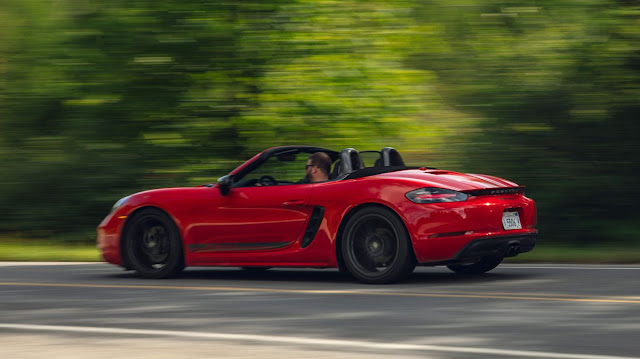Tested: 2023 Porsche 718 Boxster T Is Everything You Want and Nothing You Don't
By throwing every agility booster at the base powertrain, Porsche built an affordable athlete that begs to be wrung out.
There were many who bemoaned the Porsche 718 Boxster's switch from a standard flat-six engine to a turbocharged flat-four. And while Porsche has reintroduced the six in headlining variants such as the GTS 4.0 and the Spyder RS, the brand also is out to bolster the cred of even the entry-level four-cylinder Boxster. The 2023 Boxster T does exactly that.
The premise behind the Boxster T is simple: Take the whole kit and caboodle of Porsche's handling options and slap those bad boys onto the base model. Like its bigger brother, the 911 Carrera T, the Boxster T relies on its entry-level powertrain, but unlike the 911, it doesn't throw a bunch of weight savings into the mix by deleting seats and thinning the glass—although the occasionally frustrating loop door pulls might save a handful of grams. Our Boxster T tipped the scales at 3069 pounds, just 10 pounds more than a base manual Boxster we tested back in 2017. European models shed a bit more weight thanks to an infotainment delete that our backup-camera regulations don't allow.
Here's what your hard-earned $76,050 gets you on the Boxster T. Porsche's PASM sport suspension adds adaptive damping and lowers the car by 0.8 inch. The 20-inch wheels offer a dash of extra style while retaining enough sidewall rubber to avoid trashing the ride quality. Active engine mounts work to isolate the flat-four's movements from the rest of the body by varying their stiffness, while brake-based torque vectoring is on hand to improve turn-in and stability through corners. Porsche's Sport Chrono option is standard, as well, adding a dashboard clock, a drive-mode switch on the steering wheel, rev-matching downshifts, and—on cars with the seven-speed PDK dual-clutch automatic transmission—launch control.
The interior gets a little extra love too. The Boxster T comes standard with two-way power adjustable seats covered in a combination of leather and grippy cloth surfaces, and they're great, offering lots of comfort and support whether the driving is sedate or sporty. Our test car also had the optional 718 T Interior package ($2770), which brings contrasting stitching, seat embroidery, and color-matched seatbelts. You still get the plastic-fantastic base interior, but your hands likely won't stray from the wheel to massage the dash very often.
Sounds like a good combo, right? It is. Even with its larger wheels, the Boxster T's adaptive dampers do an impressive job soaking up Michigan's heavily blemished roads and returning a smooth ride that still keeps body motions in check when attacking switchbacks. Sport mode stiffens things up but doesn't necessarily add any additional precision. Those 20-inch wheels may add a smidge of unsprung mass, but the steering is still direct and happy to tell you what the front tires are experiencing. Around the 300-foot skidpad, we measured a solid 1.03 g of pavement adhesion.
With just 300 horsepower and 280 pound-feet of torque on tap, the Boxster T certainly lacks the outright hustle of a GTS 4.0 or even an S model, but it's not like waiting for a late-arriving bus. With the exception of the lowest depths of the rev range, the turbocharged 2.0-liter flat-four builds boost quickly as the exhaust note changes from flat-brim-cap bass to a more fitting yowl. With clean footwork and one of our favorite six-speed manuals underhand, we recorded a 4.3-second run up to 60 mph, exactly the same as we achieved in 2017, and four-tenths of a second quicker than a 2.0-liter Toyota Supra. Keep your foot in it, and the T will run the quarter-mile in 12.9 seconds at 109 mph, 0.1 second ahead of the 2017 Boxster and 0.4 ahead of the Supra.






